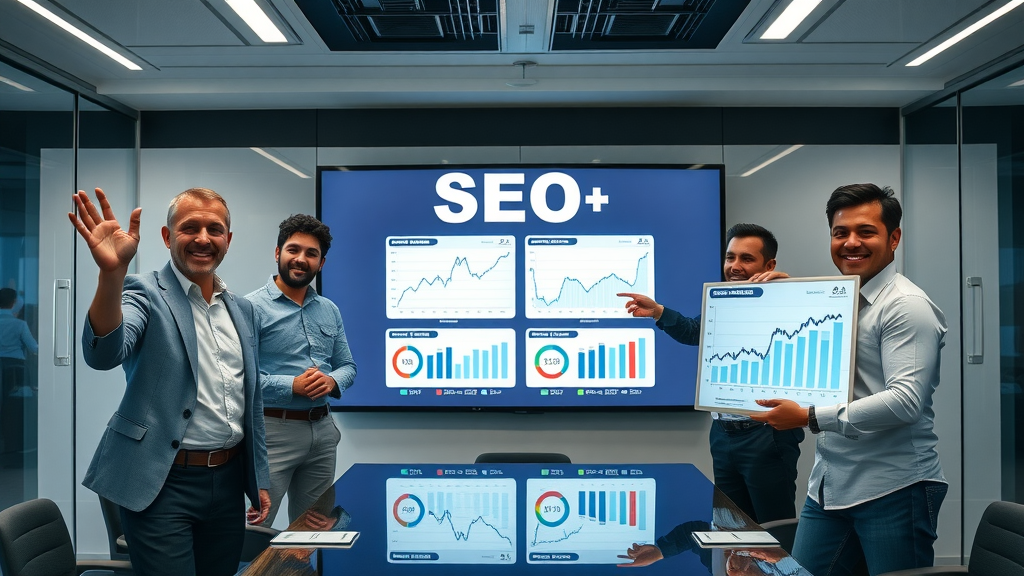Did you know that nearly 70% of marketers consider SEO content optimization their top priority for driving organic traffic? If you’ve ever wondered how some websites skyrocket to the top of Google overnight, the answer lies in effective content optimization. Whether you run an established site or just published your first blog post, fixing your SEO content issues can mean the difference between showing up on page one or being invisible in search results. This comprehensive guide shows you exactly how to resolve content optimization issues within 24 hours, so you can gain more visibility, improve your rankings, and see fast results.
Startling Stats: Why SEO Content Optimization Matters Now
SEO content optimization has never been more critical. In today’s fast-paced digital marketplace, over 80% of consumers start their buying journey with a search engine. Without optimized content, your website risks getting buried beneath competitors who understand and leverage current SEO content trends. Not only does strong optimization boost organic traffic, but it also increases user engagement and conversion rates—key elements to hitting business goals.
Understanding the impact of content optimization unveils just how crucial it is for online visibility. The explosion of mobile usage and voice search, combined with frequent updates to Google’s algorithms, means every business needs to prioritize optimized content to remain competitive. With proper strategies in place, you’ll gain a sustainable edge, ensure your content matches search intent, and achieve high page SEO scores. The bottom line: optimized content attracts, engages, and converts your audience faster and more effectively than outdated tactics.

Nearly 70% of marketers say SEO content optimization is their top priority for driving organic traffic. – Search Engine Journal
What You'll Learn About SEO Content Optimization
- How to identify and fix common SEO content optimization errors
- Step-by-step guidance for optimizing content for search intent
- Keys to effective keyword research and using secondary keywords
- Best practices for creating optimized content that ranks
- Insider tips to improve your content for featured snippets
- How to structure internal links for enhanced page SEO
- Actionable checklists for creating content that works
Understanding SEO Content Optimization: A Complete Guide
What is SEO Content Optimization?
SEO content optimization is the process of refining and structuring your website content to ensure it meets the criteria set by search engines, thereby boosting your site’s visibility and ranking. This includes targeting relevant keywords, improving readability, enhancing user engagement, and ensuring the content aligns with search intent. Content optimization isn’t a one-time event—it’s an ongoing practice that adapts with algorithm changes and audience expectations.
Every time you create a blog post or update an older piece, you’re actively engaging in the content optimization process. By focusing on both technical and user-facing elements—such as meta descriptions, heading structure, keyword density, and internal links—you position your pages to efficiently answer users’ queries and satisfy Google’s ranking signals. When executed well, SEO content optimization can drastically increase organic traffic and keep your website ahead of the competition.
The Role of Content Optimization in Modern SEO Strategy
Modern SEO is a multifaceted discipline, with content optimization at its core. Today’s successful content strategies blend technical SEO, keyword research, and high-quality writing to satisfy both human readers and search engine algorithms. By analyzing user search behavior and matching content types to search intent, you’re able to create relevant, valuable content that meets the needs of your target audience.
Without optimization, even the most insightful blog posts can stay unseen. Content that is properly optimized not only ranks higher but also provides a positive user experience. This synergy between technical structure and meaningful information is vital—ensuring visitors stay longer, explore multiple pages, and convert from readers to customers. Ultimately, investing in SEO content optimization pays dividends in brand authority, organic visibility, and bottom-line business results.
Why Optimized Content is Critical for Online Visibility
Search engines are designed to serve users the most relevant and useful responses to their queries. Through thorough optimization, your content for SEO will stand out to algorithms and real users alike. Optimized content increases your chances of being featured in featured snippets and other high-visibility areas like the coveted top 3 search results.
Not only does optimization drive organic traffic, but it also builds trust and authority in your niche. By consistently delivering answers to user questions and addressing pain points, you position your site as an indispensable resource. When your content strategy includes regular audits, updates, and keyword enhancements, you’re poised to capture and sustain a prominent spot in search results, ensuring your efforts aren’t wasted.

Key Principles of Effective SEO Content Optimization
Aligning Content Optimization with Search Intent
One of the foundational elements of successful SEO content optimization is aligning your writing with search intent. Before diving into content creation, it’s crucial to grasp what users are actually looking for when they type a specific query into Google. Are they seeking information, trying to solve a problem, or ready to make a purchase?
By determining the intent behind top keywords, you can tailor your articles to answer user questions comprehensively, thereby increasing dwell time and decreasing bounce rates. Google and other search engines reward content that resonates with user needs by ranking it higher in search results. Carefully researched and intent-focused content not only attracts more targeted visitors but also ensures a better user experience—a fundamental factor in modern SEO success.
SEO Content Creation: The Foundation of Optimized Content
Creating optimized content starts with a deep understanding of your target audience. Effective content creation involves more than stuffing keywords into text—it’s about offering unique value through actionable advice, thorough explanations, and credible resources. Each piece of content should be mapped to a phase of the user journey, ensuring every article answers specific questions or solves particular problems.
In-depth content that covers a topic holistically tends to perform better, both with users and with search engines. To create content that stands out, structure your posts with logical headings, relevant internal links, and multimedia elements like images or videos to break up large text blocks. The right blend of technical finesse and creative value will help your site climb the rankings and make a lasting impression on your visitors.
Incorporating Primary and Secondary Keywords
Effective keyword research is vital for SEO content optimization. Start by identifying your main keyword, which anchors the central theme of your content. Supplement this with secondary keywords that are closely related topics or variations, giving your content a broader reach and relevance.
Strategically placing both primary and secondary keywords ensures your content will address more search queries and rank for longer-tail variations. Remember, natural integration is key—avoid keyword stuffing and instead focus on semantic relevance. Regularly updating your content with new secondary keywords keeps it fresh and adaptable to evolving search trends, improving your chances for higher rankings and featured snippet placements.
Ensuring Your Target Keyword Drives Your Message
Your target keyword should not only appear in critical elements like the title tag, meta description, and first paragraph, but also shape the message and flow of the entire page. Doing so signals to search engines that your content is precisely what users are searching for, improving your relevance and visibility.
Using the target keyword to guide your subheadings, supporting content, and internal link strategy guarantees that each section supports your main topic. Keep assessments ongoing—track keyword performance in tools like Google Search Console and adjust as user behavior shifts. Ultimately, letting your target keyword drive your message ensures you consistently meet the needs of your intended audience.

| Issue | Fast Solution | Impact on SEO |
|---|---|---|
| Thin content with low word count | Add relevant details, examples, and supporting media | Enhances authority and keyword relevance |
| Duplicate content across pages | Consolidate or rewrite duplicate sections | Improves indexation and avoids ranking penalties |
| Lack of internal links | Add contextual internal links to relevant pages | Boosts page SEO and site structure |
| Keyword stuffing/over-optimization | Rephrase for natural language and LSI keyword usage | Restores readability, maintains ranking potential |
| Poor meta descriptions or missing title tags | Craft engaging and keyword-rich meta tags | Increases click-through rates from search |
Analyzing and Auditing Your Existing SEO Content
How to Conduct a Rapid SEO Content Audit
Conducting a quick yet thorough content audit is the first step to uncovering optimization opportunities. Start by listing all existing pages, then use tools like Google Analytics and SEMrush to identify underperforming content. Check for low-traffic posts, high bounce rates, and pages that don’t rank for their target keywords.
Once potential issues are found, compare each page against current SEO best practices, such as keyword integration, heading structure, internal links, and the presence of optimized meta tags. Assess whether your content for SEO matches user search intent. The goal is to systematically identify which pages need content updates, technical improvements, or structural changes so you can prioritize for the greatest impact in the least time.

Identifying Gaps in Content Optimization
Gaps in content optimization often arise when your content doesn’t fully answer user queries or lacks depth compared to top-ranking competitors. Use competitive analysis to benchmark your content against what’s already ranking on page one. Look for missing sections, outdated information, or opportunities to add more detail and visual aids.
It’s also important to review the logical flow of your text and the presence of internal links. Gaps are often found where users drop off or when content doesn’t transition smoothly from one idea to the next. Address these issues by expanding on subtopics, adding relevant statistical insights, and ensuring all content aligns closely with the original search intent of the keyword you’re targeting.
Keyword Research for SEO Content Optimization: Step by Step
How to Find the Best Keywords for Your Content
Keyword research is the foundation of successful SEO content optimization. Start by brainstorming terms your audience uses, then validate these with keyword research tools like Ahrefs, SEMrush, or Google Keyword Planner. Look for keywords with solid search volume and low to moderate competition for the best chance to rank high in search results.
Evaluate keyword intent by reviewing SERP features—do the top results for your term prioritize informational guides, product pages, or tutorials? By pinpointing which keywords best match your content, you can better align with what users and search engines expect. Always prioritize the terms that drive the most qualified traffic and are relevant to your niche.
Uncovering Opportunities: Secondary Keywords and Search Intent
Secondary keywords are related phrases or questions that support your main topic. Including these helps your content address broader search intent and increases the chance of appearing for long-tail queries and in featured snippets. Tools like Answer the Public or SEMrush’s Keyword Magic Tool make it easy to uncover popular secondary keywords tied to your core focus.
Map these secondary keywords naturally into your content—through headings, descriptions, and supporting paragraphs—to boost semantic relevance and topical authority. Over time, updating existing posts with high-impact secondary keywords ensures your content remains comprehensive, current, and highly visible in organic search results.

Competitor Keyword Analysis for More Optimized Content
Analyzing which keywords drive traffic to top-performing competitor sites reveals powerful opportunities for your own strategy. Use tools like SEMrush or Ahrefs to identify their winning keywords, content themes, and backlink profiles. Compare your own pages: which relevant keyword gaps exist, and which topics need more depth?
By integrating these insights into your own content marketing plan, you can create detailed, higher-value articles that outrank the competition. Identify the unique selling points your site offers and use those to differentiate your content for SEO. Consistently reviewing competitor optimizations inspires fresh ideas and ensures your content continuously evolves for maximum ranking potential.
"Comprehensive keyword research is the backbone of effective SEO content optimization." – Neil Patel
Create Content That Ranks: Strategies for SEO Content Optimization
Best Practices in Content Creation and Optimization
Building content that ranks is about more than adding keywords—it's the synergy of research, structure, and value. Utilize clear and concise introductions that address the reader’s search intent right away, and ensure every heading and subheading is keyword-rich and informative.
Enhance readability by breaking up large blocks of text, adding multimedia (images, videos, infographics), and using lists and tables to highlight important information. Always provide authoritative references and relevant internal links to support trust and navigation. Regularly review content to keep pace with shifts in search algorithms and changing user needs.
Writing for Featured Snippets: How to Optimize Your Content
To win featured snippets, structure your content with concise answers, question-based headings, and succinct bullet points or numbered lists. Analyze the types of snippets (paragraphs, lists, tables) that appear for your target keywords and model your formatting accordingly.
Use schema markup where relevant, as this helps search engines better understand your page structure. Provide direct answers high up in your articles and utilize clear, simple language. Continuously update and refine sections to respond to new search trends, as content that frequently adapts is more likely to be picked for snippet boxes.
Optimizing Meta Description, Title Tags, and H1 Headers
An engaging title tag and meta description play a pivotal role in driving click-throughs from search results. Ensure your main keyword is placed near the beginning of both elements. Titles should be clear, compelling, and under 60 characters, while meta descriptions should summarize your content and include a call-to-action in about 155 characters.
The H1 header should succinctly describe what the page is about, using the target keyword. Make each heading hierarchy logical, with subtopics clearly supporting the main subject. Consistently reviewing and refreshing these elements is key to staying relevant and competitive.

Using Internal Links to Improve Your Content and Page SEO
Internal links connect relevant pages and posts within your site, strengthening your overall website architecture. Strategically placed internal links improve user navigation, establish hierarchical relationships, and distribute link equity to important pages.
Make sure your anchor text is descriptive and naturally fits the context. Integrate links to both cornerstone content and related articles, guiding search engines and users alike. Routinely auditing and updating your internal linking structure maximizes page SEO benefits and ensures all high-value content is easily accessible.
Content Marketing Tactics for Enhanced SEO Performance
Powerful content marketing initiatives combine SEO best practices with creative outreach. Share optimized blog posts on social media, build backlinks through guest posting, and leverage influencer marketing for broader reach.
Promote content updates and new articles via email lists and press releases. Always analyze which marketing channels yield the highest engagement and referral traffic. The better your synergy between marketing and SEO content optimization, the stronger your long-term website authority and lead generation pipeline will become.
- Craft compelling introductions aligned with search intent
- Use keyword-rich headings and subheadings
- Break up text with lists and tables for skimmability
- Add rich media to boost user experience and engagement
- Link out to authoritative sources and relevant internal content
Watch: Short video: How to optimize your content for featured snippets (step-by-step demo)
Improve Your Content for User Experience: A Quick Checklist
- Keep paragraphs short and focused
- Use bullet points for clarity
- Add images with descriptive alt tags optimized for SEO content
- Ensure mobile friendliness
- Test page speed and fix slow-loading elements

On-Page SEO Essentials for Content Optimization
Optimizing Title Tags and Meta Descriptions
A powerful title tag and meta description can be the difference between a user clicking your link or scrolling past. Conduct A/B testing on variations, focusing on clarity, keyword prominence, and emotional appeal. Write title tags that promise value and meta descriptions that deliver a concise summary of what readers can expect.
Ensure that each page has a unique and naturally keyword-integrated title tag and meta description. Double-check that descriptions are the correct length and that both elements are compelling enough to drive clicks from search engine results pages (SERPs).

How to Use Headings (H1, H2, H3) Effectively in SEO Content
Proper heading structure is fundamental for both users and search engines. The H1 should declare the main topic and contain your target keyword. H2 and H3 headings break the content into organized, digestible chunks, each supporting the main theme while incorporating secondary keywords.
Use headings to guide readers smoothly through your page, highlight the flow of ideas, and ensure each section answers an aspect of the user's query. Logical heading hierarchy also signals to search engines what topics are most relevant, improving indexing and boosting your on-page SEO score.
Best Practices for Internal Linking Structure
An effective internal linking structure ensures that authority flows throughout your site and vital content is easily discovered. Always link to cornerstone and high-traffic pages from newer articles, and vice versa. Use descriptive anchor text that reflects the page being linked to for optimal relevance.
Avoid “orphan” pages by ensuring every indexable piece of content receives at least one internal link. Maintain updated sitemaps and routinely audit your links for broken or outdated connections. This ongoing process not only improves SEO but also enhances the user experience by keeping navigation clear and intuitive.
| Task | Recommended Tool | Priority |
|---|---|---|
| Keyword research | Ahrefs, SEMrush | High |
| Content audit | Google Analytics, Screaming Frog | High |
| Meta tag optimization | Yoast SEO, Rank Math | Medium |
| Internal linking | Sitebulb | High |
| Image optimization (alt tags, compression) | TinyPNG, ShortPixel | Medium |
Troubleshooting Common SEO Content Optimization Errors
How to Fix Thin Content and Duplicate Content Issues
Thin content dilutes your site’s authority and leaves search engines confused about your expertise. Enrich these pages by adding unique insights, data, case studies, and multimedia. Use canonical tags or combine similar posts to remedy duplicate content issues, ensuring that each topic is addressed thoroughly and only once.
Check your blog posts regularly for overlaps, and refresh outdated content with current research. This approach improves relevance, stops keyword cannibalization, and prevents search ranking penalties. Quality always outweighs quantity—strive for posts that offer genuine value and comprehensive solutions to user queries.
Dealing with Over-Optimization and Keyword Stuffing
While it’s tempting to load your content with keywords, over-optimization can harm readability and result in search engines penalizing your pages. Focus on natural, conversational language; prioritize user experience over strict keyword density. Use synonyms, related terms, and semantic variations to cover a topic thoroughly without repetition.
Regularly review your site for outdated optimization practices and ensure every blog post or landing page reads well to human visitors first. This careful balance helps you maintain ranking potential while making your site more engaging and trustworthy.
How to Make Sure Your Content Addresses Search Intent
The heart of effective content optimization is staying focused on user intent. To do this, analyze the SERPs for your target keyword: do users want a quick answer, an in-depth guide, or a product? Mirror the format and depth of top-ranking pages while adding your own twist or extra value.
Solicit reader feedback and run A/B tests to see which angles resonate best. As Google evolves, so do user expectations—so it’s vital to keep testing, adjusting, and monitoring both behavioral and performance data.
Ensuring Your Optimized Content Fills All Relevant Gaps
No page should leave readers searching for more. Use thorough competitor research, FAQs, and user query analysis to guarantee comprehensive coverage of your topic. Supplement written content with charts, tables, or videos as needed.
Always finish by asking: Did I answer every possible question about this subject? This mindset, combined with ongoing content updates, ensures your site remains relevant, authoritative, and worthy of top rankings.

Watch: Explainer video: Common SEO content optimization mistakes and how to fix them quickly
Advanced SEO Content Optimization Techniques for 2024
Using AI for SEO Content Creation and Optimization
Leveraging AI-driven platforms, such as Jasper or ChatGPT, significantly accelerates content creation and optimization. These tools analyze existing search data, suggest relevant keywords, and can even create structured outlines for you. Integrating AI into your process ensures your site quickly capitalizes on emerging search trends and content opportunities.
AI also identifies content gaps, recommends new internal links, and automates repetitive optimization tasks—making the process much faster and more scalable. Just remember: combine machine insights with human creativity to maintain authenticity and reader engagement.

Schema Markup and Featured Snippets Optimization
Adding schema markup to your content helps search engines understand and categorize your information, boosting the chances of appearing in featured snippets, rich cards, and voice search results. Use schema for reviews, FAQs, how-to guides, and product pages to enhance SERP visibility.
Test your schema implementation with Google’s Rich Results tool and update as needed to maximize feature eligibility. Structured data not only supports snippet inclusion but also builds trust with users seeking quick, reliable answers.
Content Marketing Integration for Maximum Impact
Blending SEO with content marketing extends your reach far beyond organic search. Share insights, case studies, and updates across social platforms to attract links, followers, and industry attention. The most successful SEO programs treat blog posts as content marketing assets, repurposing articles into videos, infographics, or eBooks.
Collaborate with influencers, join expert roundups, and engage in guest posting to diversify your backlink profile. The more your content is shared and referenced, the stronger its authority and search visibility will be in the long run.
| Tool | Key Feature | Pros | Cons |
|---|---|---|---|
| SEMrush | Comprehensive site audit | Extensive keyword and backlink data | Higher pricing |
| Ahrefs | In-depth competitor analysis | Accurate traffic estimates | Learning curve for beginners |
| Surfer SEO | On-page SEO recommendations | Content editor and benchmarking | Monthly limits on queries |
| Jasper AI | AI-powered content writing | Accelerates content creation | Requires human editing |
| Yoast SEO | WordPress plugin for optimization | Easy to use, integrates easily | Limited outside of WordPress |
How to Optimize Your Content for Local SEO
Incorporating Local Search Intent
Optimizing for local SEO means understanding what your community searches for and tailoring your content accordingly. Integrate city or neighborhood names with your target keywords to signal local relevance. Analyze Google’s “near me” queries to see which terms and services are trending in your location.
Include local customer testimonials, directions, and service area information for maximum relevance. This strategy ensures your business appears in both local packs and regular organic search, drawing targeted traffic from the regions you serve best.
Optimizing for Google My Business and Local Packs
Creating and fully optimizing a Google My Business listing is one of the fastest ways to improve local visibility. Keep business hours, locations, and services updated. Add photos, collect positive reviews, and promptly answer queries to boost engagement signals.
Use consistent NAP (Name, Address, Phone) data across your website, business directories, and social media profiles. Embed a Google map on your site and encourage happy customers to leave reviews—these actions all increase your chances of showing in local packs and maps.

Case Studies: Before and After SEO Content Optimization
Real-World Examples of Improved SEO Content
Consider a small e-commerce store struggling to appear for competitive keywords. After a targeted round of content optimization—including rewriting product descriptions, adding FAQ sections, and enhancing internal linking—the site saw a 40% increase in organic traffic within two weeks.
Another local business improved its visibility by updating all meta descriptions, implementing schema markup, and earning local backlinks. The business not only climbed into the local map pack but also doubled bookings after its listing ranked for high-traffic regional queries. These real-world improvements show the remarkable impact of focused SEO content optimization efforts.

Results Achieved in Under 24 Hours
While significant ranking jumps can take weeks, immediate wins are possible. One blog updated all title tags, optimized meta descriptions, and fixed internal links in a single day. The next morning’s analytics revealed a 20% spike in click-through rates and several newly indexed posts in featured snippets. Strategic, focused changes lead to tangible results in a short timeframe.
Quick wins often come from optimizing existing content for search intent, correcting crawl issues, or refreshing outdated data—proving that even in just 24 hours, you can make a meaningful difference to visibility and performance.
Lists: 20 Actionable Tips to Optimize Your Content Fast
- Identify your target keyword and search intent
- Audit your current content for gaps
- Incorporate primary and secondary keywords
- Refine meta descriptions and title tags
- Add relevant internal and external links
- Optimize images with alt tags for content optimization
- Structure content using H2, H3 headers
- Add bullet lists and tables for clarity
- Improve readability and user engagement
- Remove duplicate or overlapping content
- Update outdated statistics and sources
- Format for featured snippets (use Q&A, lists)
- Compress images and improve page speed
- Check for mobile responsiveness
- Align calls-to-action with user intent
- Focus on content marketing best practices
- Use AI tools for content suggestions
- Review competitor content optimization strategies
- Monitor performance with analytics
- Repeat optimization regularly
People Also Ask: Is SEO Hard for Beginners?
Is SEO hard for beginners?
SEO can seem complex for beginners due to its many moving parts—keywords, on-page elements, technical factors, and ongoing updates. However, starting with basics like keyword research, meta tag optimization, and internal linking makes it much more approachable.
Plenty of free and paid tools are available to guide newcomers, and step-by-step guides like this break down tasks into manageable actions. Focus on learning the fundamentals and implementing best practices one at a time to build confidence and understanding over time.
People Also Ask: What are the 4 Types of SEO?
What are the 4 types of SEO?
The four main types of SEO are:
- On-page SEO: Optimizing content, headings, images, and metadata on each page.
- Off-page SEO: Building authority via backlinks and social proof from other websites.
- Technical SEO: Ensuring site speed, mobile-friendliness, XML sitemaps, and structured data.
- Local SEO: Optimizing for regional keywords, business listings, and map pack visibility.
People Also Ask: What is the 80/20 Rule for SEO?
What is the 80/20 rule for SEO?
The 80/20 rule in SEO means that 80% of your organic results often come from 20% of your content. Focus your energy on optimizing the pages and posts that drive the majority of your traffic and conversions. Regularly update your top-performing content to maximize returns and allocate resources more effectively.
Applying this principle helps streamline your content optimization and ensures your efforts have the greatest possible impact on search performance.
People Also Ask: What is an Example of Content Optimization?
What is an example of content optimization?
A practical example: say you have a blog post about “how to make cold brew coffee.” Content optimization would involve adding related secondary keywords (like “best cold brew recipes”), including bullet-pointed instructions, inserting an FAQ section, and updating the meta description and images with relevant alt tags. These improvements help your post answer more queries, appear for a wider range of searches, and offer a better user experience.
FAQs on SEO Content Optimization
-
How long does SEO content optimization take to show results?
While some improvements can drive visible changes in a day, most SEO gains accumulate over a few weeks as search engines recrawl and re-rank your updated pages. -
What tools are best for quick content optimization?
Leading tools include SEMrush, Ahrefs, Surfer SEO, and Yoast SEO for WordPress. Each helps you audit, optimize, and monitor results efficiently. -
Can optimized content help with voice search?
Yes—well-structured, concise answers using natural language increase the chances of your site being chosen for voice search results. -
Is it possible to over-optimize your content?
Absolutely. Avoid keyword stuffing and unnatural phrasing, as both harm user experience and risk search penalties. Always put readers first. -
How often should SEO content be updated for best results?
Review top pages quarterly or after major search algorithm updates, updating as needed with new keywords, data, and answers to emerging user questions.
Key Takeaways: SEO Content Optimization in 24 Hours
- SEO content optimization is a critical, ongoing process
- Addressing technical and on-page content optimization yields fast results
- Tools, checklists, and expert guidance accelerate your path to optimized content success
Conclusion
Optimizing your content for SEO doesn’t have to take weeks—these strategies make it possible in just 24 hours. Need Help? Call Digital Media Marketing at 1-586-997-0001.
For more in-depth strategies and actionable insights, read The Ultimate Guide to Content Marketing: Strategies, and How to Build a Winning Plan.
 Add Row
Add Row  Add
Add 




Write A Comment